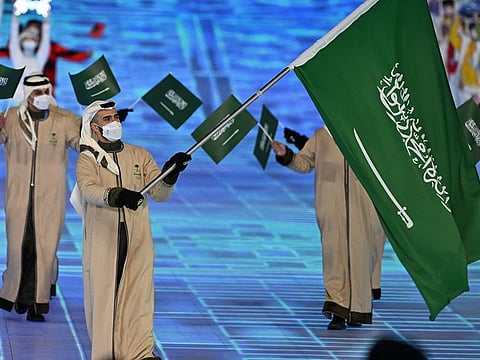Saudi Arabia celebrates Flag Day for the first time
Kingdom honours rich history dating back to the first Saudi state in 1727 AD

Dubai: For the first time, Saudi Arabia celebrated its Flag Day on Saturday.
March 11 has been designated by a royal decree issued by King Salman who declared the day as Flag Day to honour the Saudi Arabian flag, which has a rich history dating back to the first Saudi state in 1727 AD.
The history of the flag dates back to the banner of Imams of the first Saudi state, who founded the state and unified its territories. The flag has undergone several changes, and the final design was approved on March 11, 1937.
The Saudi Flag bylaw was issued in 1973, stipulating that the flag should be rectangular in shape, green in colour, and with the creed “There is no god but Allah, Mohammad is the Messenger of Allah” in the middle.
A drawn sword with its grip directed to the lowest part of the flag is placed below parallel to the words of monotheism written in Thuluth script.
Special characteristics
The Saudi flag is unique among the flags of the world and has special characteristics that bestow on it an aura of awe, reverence, and glorification.
It is prohibited to wrap the flag on the bodies of dead kings and leaders, nor is it lowered at half-mast on occasions of grief, and it does not bow to the guests who review the guard of honor.
Even on official holidays, the national flag is raised atop all government buildings and public institutions inside the Kingdom and its missions abroad. The flag can be flown only when in good shape and in accordance with international protocol.
According to Article 13 of Saudi Arabia’s Flag Law, the flag is considered forbidden to be lowered and has not touched any surface, ground, or water since it was first raised.
Several laws and regulations have been put in place to protect the Saudi Arabian flag. The laws include specific terms, conditions, protocols, and penalties for those who violate them.
Citizens attending flag-raising ceremonies or during the playing of the national anthem must stand firmly in front of the flag until the end of the ceremony. It is also forbidden to use the Kingdom’s flag as a commercial material or trademark, or for the purpose of commercial advertising in any form.
Furthermore, it is forbidden to insult the Kingdom’s flags, which include the national flag or the royal flag. Anyone who violates this law will be punished with imprisonment for a period not exceeding one year or a fine not exceeding SR3,000.
The flag must always be clean and ironed, and carefully inspected each time it is raised. The flag should be replaced periodically to ensure that it retains its colour and glow.
If the flag is old, torn, damaged, or has changed its colour and is in a condition that is not good enough to be used, it should be destroyed by the party that uses it.
Calligrapher dies
However, on this historic day, Abdullah Otaibi, the calligrapher who wrote the two testimonies on the flag, passed away at the age of 85. He was a renowned calligrapher who contributed significantly to the development of the art in Saudi Arabia.
He wrote the testimonies on the Saudi flag with a special type of calligraphy known as Diwani, a style known for its beauty and complexity.
Otaibi was born in Riyadh in 1938 and studied calligraphy in Saudi Arabia and Egypt. He was considered one of the most important calligraphers of his generation and received numerous awards for his contributions to the field.
Sign up for the Daily Briefing
Get the latest news and updates straight to your inbox


